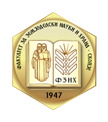YIELD OF NITRATE ACCUMULATIONS IN SPINACH (SPINACIA OLRACEA L.), WITH DIFFERENT FERTILIZATION SYSTEMS
Keywords:
mineral, organic fertilization, quality, reduced mineral, spinach, yieldAbstract
Spinach production is based on a conventional cultivation system. This form of cultivation, due to excessive use of mineral fertilizers, pesticides and other inputs in production, can lead to an unbalanced relation and disruption of natural processes in the soil. Due to this fact, various spinach fertilization systems are being examined in order to ensure health value and environmental protection. A two-factorial (locality and fertilization) one-year study was conducted by random block schedule in four replications. The study examined the influence of different localities (Krizevci in Croatia and Velika Kladusa in Bosnia and Herzegovina) and fertilization systems (mineral, reduced mineral and organic) on yields and nitrate concentrations, as well as the amount of vitamin C in the spinach variety Norvak. Analysis of variance indicates a high and statistically justified (P < 0.05) influence of localities and fertilization on height, spinach yield and nitrate concentration. Due to economic and environmental justification, a reduced mineral fertilization system should be applied in further practice, because the obtained yield and yield components do not differ statistically from those obtained using mineral fertilization, and benefits are multiple (better product quality and less environmental pollution).
Key words: mineral, organic fertilization, quality, reduced mineral, spinach, yield



